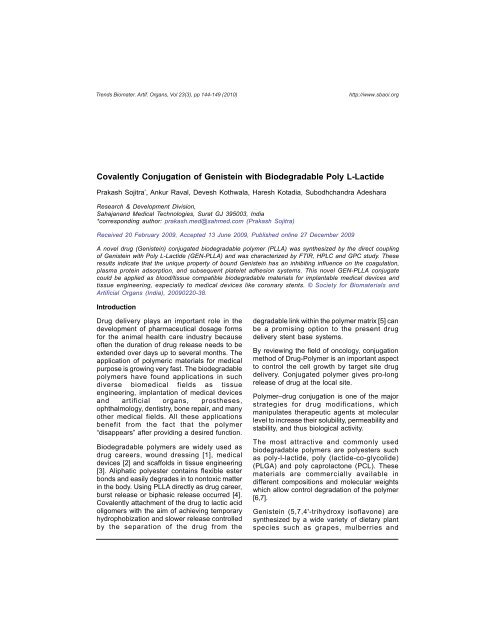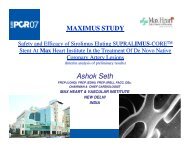Covalently Conjugation of Genistein with Biodegradable Poly L ...
Covalently Conjugation of Genistein with Biodegradable Poly L ...
Covalently Conjugation of Genistein with Biodegradable Poly L ...
You also want an ePaper? Increase the reach of your titles
YUMPU automatically turns print PDFs into web optimized ePapers that Google loves.
Trends Biomater. Artif. <strong>Covalently</strong> Organs, Vol <strong>Conjugation</strong> 23(3), pp 144-149 <strong>of</strong> <strong>Genistein</strong> (2010) <strong>with</strong> <strong>Biodegradable</strong> <strong>Poly</strong> L-Lactide http://www.sbaoi.org 145<strong>Covalently</strong> <strong>Conjugation</strong> <strong>of</strong> <strong>Genistein</strong> <strong>with</strong> <strong>Biodegradable</strong> <strong>Poly</strong> L-LactidePrakash Sojitra * , Ankur Raval, Devesh Kothwala, Haresh Kotadia, Subodhchandra AdesharaResearch & Development Division,Sahajanand Medical Technologies, Surat GJ 395003, India*corresponding author: prakash.med@sahmed.com (Prakash Sojitra)Received 20 February 2009, Accepted 13 June 2009, Published online 27 December 2009A novel drug (<strong>Genistein</strong>) conjugated biodegradable polymer (PLLA) was synthesized by the direct coupling<strong>of</strong> <strong>Genistein</strong> <strong>with</strong> <strong>Poly</strong> L-Lactide (GEN-PLLA) and was characterized by FTIR, HPLC and GPC study. Theseresults indicate that the unique property <strong>of</strong> bound <strong>Genistein</strong> has an inhibiting influence on the coagulation,plasma protein adsorption, and subsequent platelet adhesion systems. This novel GEN-PLLA conjugatecould be applied as blood/tissue compatible biodegradable materials for implantable medical devices andtissue engineering, especially to medical devices like coronary stents. © Society for Biomaterials andArtificial Organs (India), 20090220-38.IntroductionDrug delivery plays an important role in thedevelopment <strong>of</strong> pharmaceutical dosage formsfor the animal health care industry because<strong>of</strong>ten the duration <strong>of</strong> drug release needs to beextended over days up to several months. Theapplication <strong>of</strong> polymeric materials for medicalpurpose is growing very fast. The biodegradablepolymers have found applications in suchdiverse biomedical fields as tissueengineering, implantation <strong>of</strong> medical devicesand artificial organs, prostheses,ophthalmology, dentistry, bone repair, and manyother medical fields. All these applicationsbenefit from the fact that the polymer“disappears” after providing a desired function.<strong>Biodegradable</strong> polymers are widely used asdrug careers, wound dressing [1], medicaldevices [2] and scaffolds in tissue engineering[3]. Aliphatic polyester contains flexible esterbonds and easily degrades in to nontoxic matterin the body. Using PLLA directly as drug career,burst release or biphasic release occurred [4].<strong>Covalently</strong> attachment <strong>of</strong> the drug to lactic acidoligomers <strong>with</strong> the aim <strong>of</strong> achieving temporaryhydrophobization and slower release controlledby the separation <strong>of</strong> the drug from thedegradable link <strong>with</strong>in the polymer matrix [5] canbe a promising option to the present drugdelivery stent base systems.By reviewing the field <strong>of</strong> oncology, conjugationmethod <strong>of</strong> Drug-<strong>Poly</strong>mer is an important aspectto control the cell growth by target site drugdelivery. Conjugated polymer gives pro-longrelease <strong>of</strong> drug at the local site.<strong>Poly</strong>mer–drug conjugation is one <strong>of</strong> the majorstrategies for drug modifications, whichmanipulates therapeutic agents at molecularlevel to increase their solubility, permeability andstability, and thus biological activity.The most attractive and commonly usedbiodegradable polymers are polyesters suchas poly-l-lactide, poly (lactide-co-glycolide)(PLGA) and poly caprolactone (PCL). Thesematerials are commercially available indifferent compositions and molecular weightswhich allow control degradation <strong>of</strong> the polymer[6,7].<strong>Genistein</strong> (5,7,4'-trihydroxy is<strong>of</strong>lavone) aresynthesized by a wide variety <strong>of</strong> dietary plantspecies such as grapes, mulberries and
146 P. Sojitra, A. Raval, D. Kothwala, A. Rawal, H. Kotadia, S. Adesharapeanuts [8] and in dietary is<strong>of</strong>lavones such asbeans and legumes [9]. Phenolic rings in<strong>Genistein</strong> is are responsible for estrogenreceptor binding [10]. The hydroxyl group at theC-4’ position enhanced the antioxidantproperties <strong>of</strong> <strong>Genistein</strong> drug. The structure <strong>of</strong><strong>Genistein</strong> consisting <strong>of</strong> two benzyl rings by athree- carbon bridge, which is simplified as C 6-C 3-C 6. It is also classified as a phytoestrogensdue to its weak estrogenic activity in mammaliansystems [11].<strong>Genistein</strong> is a potential flavonoid whichpossesses anti-thrombotic and antiproliferativeproperties. Data suggest that<strong>Genistein</strong> may exert a strong anti-carcinogeniceffect, and that this effect possibly involves aninduction <strong>of</strong> p21, which inhibits the thresholdkinase activities <strong>of</strong> Cdks and associated cyclins,leading to a G2/M arrest in the cell cycleprogression [12, 13]. It inhibited collage inducedhuman platelet aggregation in a dosedependentmanner [14,15]. It has been shownto enhance NO production from theendothelium. NO is a potent inhibitor <strong>of</strong> plateletadhesion, aggregation and thrombosis.Impaired platelet production <strong>of</strong> NO has beenassociated <strong>with</strong> acute coronary syndromes.Thus <strong>Genistein</strong> may affect platelet aggregationvia an NO-dependant signal transductionpathway, a potential mechanisam. Theantitumor effect <strong>of</strong> <strong>Genistein</strong> has been reportedthrough the inhibition <strong>of</strong> protein kinasepathways leading to gene expressionmodification <strong>of</strong> many proteins, including VEGF.Novel drug-biodegradable polymer conjugatescan serve the purpose <strong>of</strong> sustained drugdelivery simultaneously <strong>with</strong> the polymerdegradation period. In the present study,<strong>Genistein</strong> was conjugated <strong>with</strong> biodegradablePLLA and was performed as coating on coronarystent.Materials and methodsThe Stainless steel 316L electropolished stents(16mm length) were used in the present study.L-Lactide (Boehringer-Ingelheim, Germany)was purified by recrystallization from dry ethylacetate and dried in vacuo at room temperature.<strong>Genistein</strong> was obtained from Ren YoungPharmaceutical Co Ltd, China and used <strong>with</strong>outfurther purification process. Stannous octoate(Sn-oct, Sigma), Dicyclohexylcarbodiimide(DCC, FLUCA), 4-(dimethyl amino) pyridine(DMAP, FALUCA), dichloromethane (DCM),Dimethyl Sulphoxide (DMSO) and otherchemicals used in the current investigationwere <strong>of</strong> HPLC grade procured from RanbaxyFine Chemicals Ltd, India.MethodsPLLA was synthesized by the reported method[16]. Briefly, L-lactide (10 g, 0.07 mol) wasmelted at 180 °C for 30min in a nitrogenatmosphere. Stannous octoate (0.1 wt % <strong>of</strong> L-lactide) was added to the melted L-lactidesolution. The mixture was degassed and stirredat 150 °C for 30 min. The product was dissolvedin chlor<strong>of</strong>orm and then precipitated in excessmethanol. The precipitate was filtered and driedovernight under vacuum.A DCC, DMAP chemistry was used to synthesizethe PLLA-<strong>Genistein</strong>. <strong>Genistein</strong> C 15H 10O 5(0.02702 gm 1x10 -4 mol) and PLLA (0.1g,2.0x10 -4 mol) was dissolved in the DMSO (50ml), N, N-dimethyl formamide (DMF, 50 ml)respectively. DCC (2x10 -4 mol) and DMAP (2x10 -4mol) were added to drop by drop PLLA solutionin DCM was added to <strong>Genistein</strong> solution <strong>with</strong>stirring for 10 min at constant 50°C. The reactionwas further carried out for 18 hours undernitrogen atmosphere. After the couplingreaction, the reaction solution was precipitatedin excess methanol. The precipitate wasdissolved in chlor<strong>of</strong>orm and the solution wasprecipitated in excess methanol. After filtering,the precipitate was dried at 35°C for 24 h invacuum to eliminate the residual solvent.HPLC analysis <strong>of</strong> <strong>Genistein</strong> were performed onHPLC-LC-2010 AHT [Shimadzu (Asia Pacific)Pvt. Ltd.] consisting <strong>of</strong> X-Terra RP-18 (250*4.6mm) analytical column having particle size 5µm.The drug content was analyzed using mobilephase consisting <strong>of</strong> acetonitrile: methanol:water (45:35:20 v/v) at flow rate <strong>of</strong> 1.2 ml/minand oven temperature 40°C. The retention timefor <strong>Genistein</strong> was kept at 2.9 minute and wasdetected at 254 nm by UV absorption.This analysis was performed on mother liquorto set molar ratio <strong>of</strong> genistein and PLLA. Liquorwas taken from the reaction mixture at each 18
<strong>Covalently</strong> <strong>Conjugation</strong> <strong>of</strong> <strong>Genistein</strong> <strong>with</strong> <strong>Biodegradable</strong> <strong>Poly</strong> L-Lactide 147hours after reaction time and was quantified byHPLC analysis for free genistein. To set Molarratio <strong>of</strong> <strong>Genistein</strong> and PLLA various experimentswere carried out in 1:1, 1:2 and 1:3.FTIR spectra <strong>of</strong> the product was recorded on‘‘Perkin Elmer FTIR Paragon 1000 SPIR S. No.42825’’ using KBr pellet technique. Thethermograms were obtained on athermobalance ‘‘Metler TA-4000 system’’ at aheating rate <strong>of</strong> 10 deg. C/min.Coating TechniqueThe <strong>Genistein</strong>-PLLA conjugation was dissolvedin 100 ml HPLC grade DCM and coated on stentusing spray coating technique to check thefeasibility <strong>of</strong> conjugation coating on stent. Thecoating process is carried out using asepticconditions under controlled environment andclass 1000 clean room conditions. Thetemperature and humidity were maintainedbelow 23°C and 60% RH respectively in cleanroom.The OLYMPUS SZX12 microscope was usedfor photography and surface cherecterization.Results and DiscussionHPLC analysis for molar ratio determinationFree amount <strong>of</strong> genistein was observed in 1:1and 1: 2 molar batches while there was noquantification was observed in 1:3 molar ratioso the reaction was further proceed <strong>with</strong> molarratio experiments.From the figures 1 and 2, it can be concludedthat in molar ration 1:3 there is no free genisteinat the end <strong>of</strong> the reaction was detected. Therefor one mole <strong>of</strong> genistein has consumed threemole <strong>of</strong> PLLA during conjugation reaction.GPC analysisThe GPC data suggest weight averagemolecular weight has decreased from 247 KDato 22 KDa. This is due to degradation <strong>of</strong> PLLAduring reaction.FTIR analysisFTIR spectroscopic method is employed to studythe <strong>Genistein</strong>(Fig. 3), PLLA (Fig. 4) and PLLA-GEN (Fig. 5) complexes wherein the changesFigure 1: Chromatogram <strong>of</strong> <strong>Genistein</strong>StandardFigure 1: Chromatogram <strong>of</strong> GEN PLLAobserved in vibrational frequencies <strong>of</strong> theirfunctional groups are explored in detail.There is a broader absorption in the 3300-3500cm -1 which can be identified by characteristic <strong>of</strong>O-H bond stretching adsorption in PLLA. Thebands at approximately 2997 and 2945 cm -1arise from the -CH 3asymmetric and symmetricstretch. These signals are related to both CH 3groups on the PLLA. However, the bands atapproximately 2858 and 2928 cm -1 , related to -CH 2symmetric and asymmetric stretch, 2881cm -1 show -CH absorption.FTIR Spectra <strong>of</strong> GEN-PLLA Conjugate shows1651 cm -1 & 1760 cm -1 shows presence <strong>of</strong>lactones ring and carbonyl <strong>of</strong> PLLA. The C-Ostretching vibration frequency <strong>of</strong> free drug at1260-1000 cm -1 (17). The infrared spectrum <strong>of</strong>GEN-PLLA implies that the vibration in GEN at3412-3104 cm -1 has disappeared in theconjugated polymer. This also reveals theconjugation <strong>of</strong> OH group <strong>of</strong> genistein. On theother way absorption <strong>of</strong> –OH <strong>of</strong> free –COOHhas also disappeared.Coating Surface CharacterizationThe stents were subjected to microscopicanalysis after coating. It can be easily seen from
148 P. Sojitra, A. Raval, D. Kothwala, A. Rawal, H. Kotadia, S. AdesharaFigure 3: FTIR spectra <strong>of</strong> <strong>Genistein</strong>Figure 4: FTIR spectra <strong>of</strong> PLLAFigure 5: FTIR spectra <strong>of</strong> GEN-PLLA
<strong>Covalently</strong> <strong>Conjugation</strong> <strong>of</strong> <strong>Genistein</strong> <strong>with</strong> <strong>Biodegradable</strong> <strong>Poly</strong> L-Lactide 149the figures that the coating surface is free fromlumps, crack, and webbing or bridging. It isproved the feasibility <strong>of</strong> <strong>Genistein</strong>-PLLAconjugation on stent surface.ConclusionFrom FTIR analysis <strong>Genistein</strong> was successfullyconjugated <strong>with</strong> PLLA. The GEN-PLLA can beapplied to stent coating, which may releasegenistein from the stent surface after stentimplantation, which may reduce the risk <strong>of</strong>restenisois and other implications which arechalanges <strong>of</strong> post implantation <strong>of</strong> stent afterangioplasty.AcknowledgementWe express our sincere gratitude to Mr. DhirajlalKotadia, Chairman, Sahajanand Group <strong>of</strong>Companies for providing financial assistanceto carry out the research work. Also thankful toMr.Jaynish Tailor for the HPLC analysis andMr.Arpit Jariwala for the literature survey andother technical help. Contributions fromresearch team <strong>of</strong> Sahajanand MedicalTechnologies (Kamal Revdiwala, Ami Raval,Jaynish Tailor, Laxman Upale, Nilesh Kadu andRahul Patel) are also gratefully acknowledged.References1. Jurgens CH, Kricheldr<strong>of</strong> HR, Kreiser-Saunders I (1998). Development <strong>of</strong> biodegradable wound coveringand first clinical results. In: Walenkamp GHIM (ed) Biomaterials in Surgery. Thieme-Verlag, New York, pp112-1202. Leenslag JW, Pennings AJ, Bos RR, Rozema FR, Boering G (1987) Biomaterials 8: 70-733. Shi FY, Gross RA, Rutherford DR (1996) Micromolecules 29:7753-77584. Cao X, Shoichet MS, 91999) Biomaterials, 20: 329-3395. Ustariz-Peyret C, Coudane J, Vert M, Kaltsatos V, Boisramene B. Journal <strong>of</strong> microencapsulation, 2000, vol.17, pp. 615-6246. Rothen-Weinhold A, Besseghir K, Gurny R. Analysis <strong>of</strong> the influence <strong>of</strong> polymer characteristics and coreloading on the in vivo release <strong>of</strong> a somatostatin analogue. Eur. J. Pharm. Sci. 5 (1997) 303-313.7. Shah V, Siewert M, Dressman J, Moeller H, Brown CK. Dissolution/ In vitro Release Testing <strong>of</strong> SpecialDosage Forms. Dissolution Technologies 9 (2002) 1-5.8. Jang, M., Cai, L., Udeani, G. O., Slowing, K. V., Thomas, C. F., Beecher, C. W., Fong, H. H., Fransworth, N. R.,Kinghorn, A. D., Mehta, R. G., Moon, R. C. and Pezzuto, J. M. (1997) Cancer chemopreventive activity <strong>of</strong>resveratrol, a natural product derived from grapes. Science 275, 218-220.9. Fotsis, T., Pepper, M., Adlercreutz, H., Fleischmann, G., Has, T., Mon-tesano, R. and Schweigerer, L. (1993)<strong>Genistein</strong>, a dietary-derived inhibitor <strong>of</strong> in vitro angiogenesis. Proc. Natl.Acad. Sci. USA 90, 2690-2694.10. Leclerq, G. and Heuson, J. C. (1979) Physiological and pharmacological effects <strong>of</strong> estrogens in breastcancer. Biochim. Biophys. Acta 560, 427-455.11. Victor Bernardo Figallo, Effect <strong>of</strong> Planting Time and Location on the Is<strong>of</strong>lavone Content and Pr<strong>of</strong>ile <strong>of</strong>Different Soybeans [Glycine max (L.) MERRILL] Cultivars; 200312. Matsukawa Y, Marui N, Sakai T, Satomi Y, Yoshida M, Matsumoto K, Nishino H and Aoike A: <strong>Genistein</strong>arrests cell cycle progression at G2-M. Cancer Res 53: 1328- 1331, 1993.13. ng Hyun Choi. Molecular Mechanism <strong>of</strong> the G2/M arrest by <strong>Genistein</strong> in Human Cancer Cells Department <strong>of</strong>Biochemistry, Dong-Eui University College <strong>of</strong> Oriental Medicine, Busan 614-052, Korea.14. Nicole Gottstein et al. Effect <strong>of</strong> <strong>Genistein</strong> and Daidzein on platelet aggregation and monocyte and endothelialfunction. British Journal <strong>of</strong> Nutrition (2003), 89, 607–615.15. Gerald Rimbach et al. Sulfation <strong>of</strong> <strong>Genistein</strong> alters its antioxidant properties and its effect on plateletaggregation and monocyte and endothelial function. Biochimica et Biophysica Acta 1670 (2004) 229– 237.16. Ajioka, M.; Enomoto, K.; Suzuki, K.; Yamaguchi, A. Bull. Chem.Soc. Jpn. 1995, 68, 2125-2131.17. Silverstein, R. M. and Webster, F. X. (1997) Characteristic group frequencies <strong>of</strong> organic molecules; inSpectrometricIdentification <strong>of</strong> Organic Compounds, pp. 95-180, John Wiley and Sons, New York, USA.




